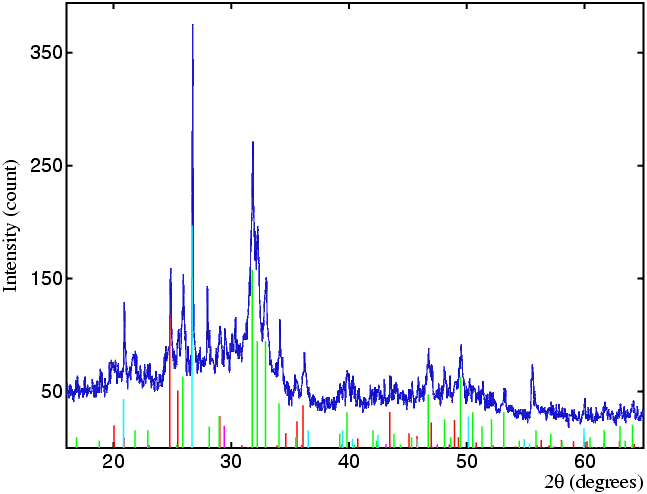 |
Forensic Analysis (Qualitative)
Archaeological Samples |
 |
Forensic Analysis (Qualitative)
Archaeological Samples |
Archaeological Samples
In general, archaeologists find PXRD useful for phase identification. This can be particularly relevant when the origin of an artifact is uncertain (see for example the Sevso Silver); though there are other uses. One study carried out here at Birkbeck in collaboration with the Museum of London, identified faked Roman coins by looking at preferred orientation. In this case, a large number of Roman coins unearthed from the banks of the Thames were suspected of being Victorian forgeries but to tell them apart required knowledge of the manufacturing process. When Roman coins were made, part of the procedure involved striking them whereas the faked coins were almost certainly cast. A struck (therefore genuine) coin shows a markedly higher degree of preferred orientation than a cast coin.
Perhaps one of the most significant uses of PXRD for archaeologists is in the phase identification of materials for authenticating artifacts. Commonly, corrosion products are analysed to determine if they are natural or have been artificially induced. Examples include bronzes which can be chemically treated to produce the green patina characteristic of the look of an ancient weathered bronze.
Analysing the material is usually not straightforward. To begin with, the objects of interest tend to be rare and valuable, so to avoid damage the samples from them are almost always very small. Together with machine time limitations, this means that the statistical quality of the data is often less than ideal. Material may also contain amorphous phases or iron. For instance, faked stone carvings can be "aged" with old engine oil, the presence of which can result in data with high background and "noise".
The diffraction pattern below is a typical example. These data were from a very small sample of a bronze fragment that had a glass infill. The sample was taken from the infill area, mounted on a flat silicon crystal and data collected for 18 hours. The data has a high background and poor signal to noise ration due to the glass phase and small sample size. Despite the data quality, four positive identifications were made with the high background inferring glass as a fifth phase. From this result, the archeologist was able to determine that the glass was part of the original object and not a recent addition.
|
||||||||
 |
To speed up phase identification, it is useful to set up a personal data base made up of standards and data relating to the particular class of materials of interest. In this case the pattern was searched against the ICDD data base and a small data base relating to copper corrosion products comprised of standards that include previous matches to similar samples. Often several analytical procedures are used in combination, such as Inductively Coupled Plasma Spectrometry, Scanning Electron Microscopy or fluorescence techniques, all of which provide supportive information and validation.
| © Copyright 1997-2006. Birkbeck College, University of London. | Author(s): Martin Vickers |